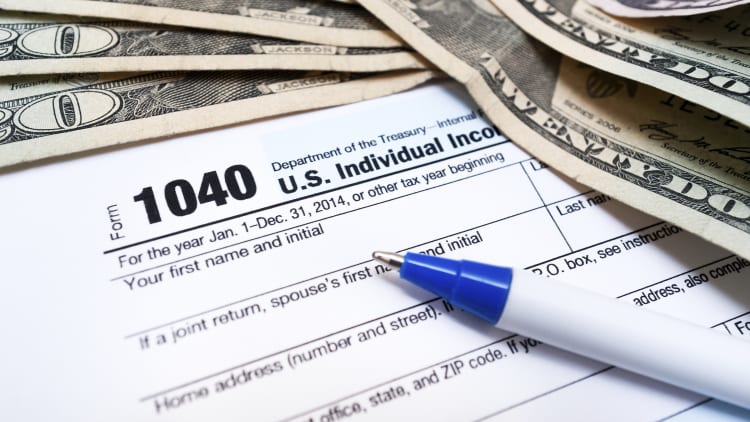Banksphotos | E+ | Getty Images
Megan Moritz bought her dream house in 2019.
However, the 1,400-square-foot home, in the Arlington Heights suburb northwest of Chicago, was built in the 1930s and lacked insulation — leading to heating bills that were “very high,” said Moritz, 48.
The first-time homeowner opted to pay about $5,700 for a series of projects last year to make her home more energy-efficient. She added insulation to the walls, and sealed gaps in ductwork connected to her furnace to prevent air leaks.
Moritz shaved her gas heating bill by half or more during the winter months, and her home is now “delightfully toasty,” she said. She slashed her bill to $102 in December 2024 from $311 two years earlier, records show. In January 2025, her bill was $116, down from $288 in 2023.
Moritz also received a $1,200 federal tax break when she filed her tax return this year, according to records reviewed by CNBC. She’s among millions of homeowners who claim a tax credit each year for retrofits tied to energy efficiency.
More from Personal Finance:
Can’t pay your taxes by April 15? You have options
There’s another surprise tax deadline on April 15
This tax strategy is a ‘silver lining’ amid tariff volatility
“The biggest perk to me, honestly, was not freezing my butt off,” said Moritz, who works for a global professional association. “Then it was the monthly bill going down as much as it did.”
“The tax credit was a nice little perk, the cherry on top,” she said.
The tax break, however, may not be available for much longer.
Republicans have signaled an intent to put the tax break and other consumer financial incentives linked to the Inflation Reduction Act on the chopping block to raise money for a multi-trillion-dollar package of tax cuts being negotiated on Capitol Hill.
What is the tax break?
The tax break — the energy efficient home improvement credit, also known as the 25C credit — is worth up to 30% of the cost of a qualifying project.
Taxpayers can claim up to $3,200 per year on their tax returns, with the overall dollar amount tied to specific projects.
They can get up to $2,000 for installing a heat pump, heat pump water heater or biomass stove/boiler, and another $1,200 for other additions like efficient air conditioners, efficient windows and doors, insulation and air sealing.
About 2.3 million taxpayers claimed the credit on their 2023 tax returns, according to Internal Revenue Service data.
The average family claimed about $880, according to the Treasury Department.
‘A much harder decision’
A thermal scan of Megan Moritz’s Chicago area home shows areas of energy inefficiency.
ARC Insulation
Blair Kennedy, a homeowner in Severna Park, Maryland, plans to claim a credit when he files his tax return next year.
Kennedy, 38, had fiberglass insulation installed in his attic and air-sealed his 3,700-square-foot home in March, a project that cost just over $6,000 after state and local rebates.
A federal tax break would reduce his net cost to about $5,000, Kennedy expects.
“I think it would’ve been a much harder decision to do it” without tax credits, said Kennedy, a real estate agent.
The tax break has been available on-and-off since Congress passed the Federal Energy Tax Act of 1978, according to a paper by Severin Borenstein and Lucas Davis, economists at the Haas Energy Institute at the University of California, Berkeley.
The original rationale for the credit was to boost U.S. energy security following energy crises in the 1970s, they wrote.
Today, the main goal of the tax break is to mitigate climate change, Davis said in an interview.
Making homes more energy-efficient helps reduce their planet-warming greenhouse gas emissions. Residential energy use accounts for about 20% of U.S. greenhouse gas emissions, according to researchers in the School for Environment and Sustainability at the University of Michigan.
The Inflation Reduction Act — a historic law to combat climate change, signed by former President Joe Biden in 2022 — extended the tax break through 2032 and made it more generous. Biden-era Treasury officials said the tax break was more popular than expected.
“A lot of these clean-energy technologies have significant benefits, but they can tend to cost a bit more than the alternative,” Davis said. “This [tax] credit offers an incentive to spend a little bit more for a capital investment that will yield climate benefits.”
Households can only claim the tax credit if they have an annual tax liability, since the credit is nonrefundable. Most of the benefits accrue to higher-income households, which are more likely to have a tax liability, Davis said.
Risk of disappearance
The IRA also included many other consumer tax breaks and financial incentives tied to electric vehicles, rooftop solar panels and energy efficiency.
Republicans in Congress may claw back funding as part of a forthcoming tax-cut package expected to cost at least $4 trillion, experts said. President Donald Trump pledged to gut IRA funding on the campaign trail, and Republicans voted more than 50 times in the House of Representatives to repeal parts of the law.
“Absolutely, there is a risk in the current budget bill that these credits would be changed or go away completely,” Davis said.
However, there’s a group of Republicans in the House and Senate seeking to preserve the tax breaks. Their support could be enough to save the incentives, given slim margins in each chamber.
About 85% of the clean-energy investments and 68% of jobs tied to Inflation Reduction Act funding are in Republican congressional districts, according to a 2024 study by E2.
Moving forward without tax break
Many households would likely still undergo energy-efficiency projects even if the tax breaks disappear, Davis said.
Savings on utility bills are often a primary motivation, experts said.
There’s generally a five- to 10-year return on investment given monthly energy savings, said Ryan Warkentien, head of ARC Insulation, which did the retrofit on Moritz’s Chicago area home.
That time frame can easily shorten to three to five years for those who qualify for a tax credit, he said.
A “crazy” high energy bill — about $1,000 in January — motivated Kennedy to get an initial energy audit to identify efficiency problems in his Maryland home. (Taxpayers can claim a $150 tax credit for the cost of such an audit.)
Kennedy is hoping to save at least 15% on his monthly energy bills. He also expects to put less stress on his heating, ventilation and air-conditioning unit to keep the house at a comfortable temperature, prolonging its lifespan and delaying future maintenance costs.
“The tax credit ended up being the icing on the cake,” he said.
Likewise for Moritz.
“I’m literally in love with my house,” she said. “The investments I make in my house are for me, because I want to spend the rest of my life here.”


 Blog Post5 days ago
Blog Post5 days ago
 Economics1 week ago
Economics1 week ago
 Economics1 week ago
Economics1 week ago
 Personal Finance1 week ago
Personal Finance1 week ago
 Accounting1 week ago
Accounting1 week ago
 Economics6 days ago
Economics6 days ago
 Personal Finance1 week ago
Personal Finance1 week ago
 Finance1 week ago
Finance1 week ago












